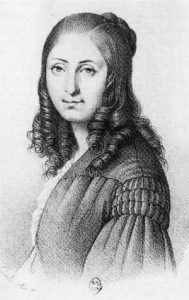Flora Tristan (1803-1844)
“Virtue and vice suppose the freedom to choose between good and evil; but what can be the morals of a woman who is not even in possession of herself, who has nothing of her own, and who all her life has been trained to extricate herself from the arbitrary by ruse, from constraint using other charms?”
Flora Tristan (1803-1844) was a French utopian socialist active in the period leading up to the European Revolution of 1848-49. While she did not live to see the revolution in France, where it started, her contributions were representative of a broader socialist and women’s movement in this country that linked the ‘Woman Question’ to class struggles.
Flora Tristan was born in Bordeaux in April 1803 to a Peruvian-born Spanish aristocrat and bourgeois French mother. An illegitimate child of an unrecognized marriage, Tristan and her mother were financially dependent on her father and they fell into financial distress upon his death. She eventually sought out her father’s family in Peru to claim her inheritance, but it was denied to her. She chronicled her experience in Peru in Pérégrinations d’une paria (Peregrinations of a Pariah 1833-1834). In it she discusses her solo journey to Peru during a tumultuous post-independence era in a time where European women did not travel alone. Tristan also denounced marriage laws in both Peru and France and viewed the lack of female autonomy within social institutions to be its own form of slavery.
In many ways Pérégrinations d’une paria was merely an affirmation of Tristan’s growing involvement in the early French socialist women’s movement in the decade before the Revolution of 1848-49. In 1827, several years prior to her escape to Peru, she became involved with the Gazette des Femmes (Women’s Journal) that primarily dealt with divorce. Her own unhappy marriage and frustration with the marriage laws that prevented her from claiming her inheritance made the Gazette des Femmes appealing to the young Flora Tristan.
Tristan’s work did not stop here. Her observation of the female condition in both France and Peru had inspired her to take up arms for a number of social issues. In 1837 she published the Petition to Reinstate Divorce. She used observations from her time in Peru to help bolster her argument and display the consequences and tragedies faced by women that were denied the right to divorce. In 1837 she published a second petition, Petition of the Abolition of the Death Penalty, in the Journal du Peuple (Journal of the People). In it she states that the injustices committed by the people are born out of necessity and created by an unjust society.
The idea that societal hierarchies played an essential role in perpetuating social issues bled into her later work. Tristan took two trips to industrial Britain after her return from Peru in 1836 and 1839. After her second visit she penned Promenades dans Londres (Promenades in London, 1840), which cautioned the working class against the dangers of the Industrial Revolution. Seeing the realities of the British working class in an industrialized economy fueled Tristan’s efforts and provided further inspiration to promote socialist work ideals.
In arguably her most famous work, L’Union Ouvrière (The Worker’s Union), published in 1843, she married both the female condition and the plight of the working class. In it she argued that the only way to liberate the working class is to liberate and incorporate women into the socialist movement. To do this she proposes a “Universal Worker’s Union” in which all members of the proletariat would belong regardless of profession or sex. To promote L’Union Ouvrière, Tristan scheduled a tour across France to bring the message of her writing to working class people. Shortly after the beginning of the tour, however, Tristan fell ill and died in 1844. More than 1,500 workers from different trade honored her death at the dedication of her tomb. She fought fiercely for the rights of women and workers until her final days.
Flora Tristan is one of the most interesting women in the early nineteenth century. Her story is a passionate one defined by self-discovery catalyzed by her travels to Peru and Britain. She is a significant historical figure and contributed positively through her writings for the emancipation of both women and the working class. Flora Tristan’s work helps perpetuate understanding of these historical struggles and serves to inspire future generations of women to fight for what they believe in.
Lauren Overton, Chemistry and Neuroscience, Class of 2019
Sources
Literature and Websites
- Amarante, Maria Inês. “Flora Tristan: Militant Journalism in a Time of Revolts.” Revista Katálysis Magazine 13, no. 1 (2010): 110-118.
- Biggs, Mary, Women’s Words: The Columbia Book of Quotations by Women, New York: Columbia University Press, 1996.
- Foley, Susan Foley, “In Search of ‘Liberty’: Politics and Women’s Rights in the Travel Narratives of Flora Tristan and Suzanne Voilquin,” Women’s History Review 13, no. 2 (2004): 211-231.
- Paulk, Julia C. “Representations of Slavery and Afro-Peruvians in Flora Tristan’s Travel Narrative, Peregrinations of a Pariah,” Afro-Hispanic Review 29, no. 1 (2010): 117-134.
- Tristan, Flora, “L’Union Ouvrière,” in Lives and Voices, Sources in European Women’s History, ed. Lisa DiCaprio and Merry E. Weisner, 102. Boston: Houghton Mifflin Company, 1998.



